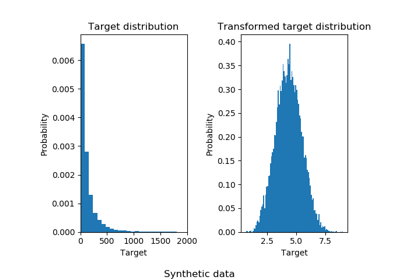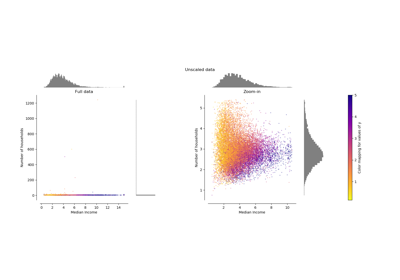sklearn.preprocessing.QuantileTransformer¶
-
class
sklearn.preprocessing.QuantileTransformer(n_quantiles=1000, output_distribution=’uniform’, ignore_implicit_zeros=False, subsample=100000, random_state=None, copy=True)[source]¶ Transform features using quantiles information.
This method transforms the features to follow a uniform or a normal distribution. Therefore, for a given feature, this transformation tends to spread out the most frequent values. It also reduces the impact of (marginal) outliers: this is therefore a robust preprocessing scheme.
The transformation is applied on each feature independently. The cumulative distribution function of a feature is used to project the original values. Features values of new/unseen data that fall below or above the fitted range will be mapped to the bounds of the output distribution. Note that this transform is non-linear. It may distort linear correlations between variables measured at the same scale but renders variables measured at different scales more directly comparable.
Read more in the User Guide.
Parameters: - n_quantiles : int, optional (default=1000)
Number of quantiles to be computed. It corresponds to the number of landmarks used to discretize the cumulative distribution function.
- output_distribution : str, optional (default=’uniform’)
Marginal distribution for the transformed data. The choices are ‘uniform’ (default) or ‘normal’.
- ignore_implicit_zeros : bool, optional (default=False)
Only applies to sparse matrices. If True, the sparse entries of the matrix are discarded to compute the quantile statistics. If False, these entries are treated as zeros.
- subsample : int, optional (default=1e5)
Maximum number of samples used to estimate the quantiles for computational efficiency. Note that the subsampling procedure may differ for value-identical sparse and dense matrices.
- random_state : int, RandomState instance or None, optional (default=None)
If int, random_state is the seed used by the random number generator; If RandomState instance, random_state is the random number generator; If None, the random number generator is the RandomState instance used by np.random. Note that this is used by subsampling and smoothing noise.
- copy : boolean, optional, (default=True)
Set to False to perform inplace transformation and avoid a copy (if the input is already a numpy array).
Attributes: - quantiles_ : ndarray, shape (n_quantiles, n_features)
The values corresponding the quantiles of reference.
- references_ : ndarray, shape(n_quantiles, )
Quantiles of references.
See also
quantile_transform- Equivalent function without the estimator API.
PowerTransformer- Perform mapping to a normal distribution using a power transform.
StandardScaler- Perform standardization that is faster, but less robust to outliers.
RobustScaler- Perform robust standardization that removes the influence of outliers but does not put outliers and inliers on the same scale.
Notes
NaNs are treated as missing values: disregarded in fit, and maintained in transform.
For a comparison of the different scalers, transformers, and normalizers, see examples/preprocessing/plot_all_scaling.py.
Examples
>>> import numpy as np >>> from sklearn.preprocessing import QuantileTransformer >>> rng = np.random.RandomState(0) >>> X = np.sort(rng.normal(loc=0.5, scale=0.25, size=(25, 1)), axis=0) >>> qt = QuantileTransformer(n_quantiles=10, random_state=0) >>> qt.fit_transform(X) array([...])
Methods
fit(X[, y])Compute the quantiles used for transforming. fit_transform(X[, y])Fit to data, then transform it. get_params([deep])Get parameters for this estimator. inverse_transform(X)Back-projection to the original space. set_params(**params)Set the parameters of this estimator. transform(X)Feature-wise transformation of the data. -
__init__(n_quantiles=1000, output_distribution=’uniform’, ignore_implicit_zeros=False, subsample=100000, random_state=None, copy=True)[source]¶
-
fit(X, y=None)[source]¶ Compute the quantiles used for transforming.
Parameters: - X : ndarray or sparse matrix, shape (n_samples, n_features)
The data used to scale along the features axis. If a sparse matrix is provided, it will be converted into a sparse
csc_matrix. Additionally, the sparse matrix needs to be nonnegative if ignore_implicit_zeros is False.
Returns: - self : object
-
fit_transform(X, y=None, **fit_params)[source]¶ Fit to data, then transform it.
Fits transformer to X and y with optional parameters fit_params and returns a transformed version of X.
Parameters: - X : numpy array of shape [n_samples, n_features]
Training set.
- y : numpy array of shape [n_samples]
Target values.
Returns: - X_new : numpy array of shape [n_samples, n_features_new]
Transformed array.
-
get_params(deep=True)[source]¶ Get parameters for this estimator.
Parameters: - deep : boolean, optional
If True, will return the parameters for this estimator and contained subobjects that are estimators.
Returns: - params : mapping of string to any
Parameter names mapped to their values.
-
inverse_transform(X)[source]¶ Back-projection to the original space.
Parameters: - X : ndarray or sparse matrix, shape (n_samples, n_features)
The data used to scale along the features axis. If a sparse matrix is provided, it will be converted into a sparse
csc_matrix. Additionally, the sparse matrix needs to be nonnegative if ignore_implicit_zeros is False.
Returns: - Xt : ndarray or sparse matrix, shape (n_samples, n_features)
The projected data.
-
set_params(**params)[source]¶ Set the parameters of this estimator.
The method works on simple estimators as well as on nested objects (such as pipelines). The latter have parameters of the form
<component>__<parameter>so that it’s possible to update each component of a nested object.Returns: - self
-
transform(X)[source]¶ Feature-wise transformation of the data.
Parameters: - X : ndarray or sparse matrix, shape (n_samples, n_features)
The data used to scale along the features axis. If a sparse matrix is provided, it will be converted into a sparse
csc_matrix. Additionally, the sparse matrix needs to be nonnegative if ignore_implicit_zeros is False.
Returns: - Xt : ndarray or sparse matrix, shape (n_samples, n_features)
The projected data.




